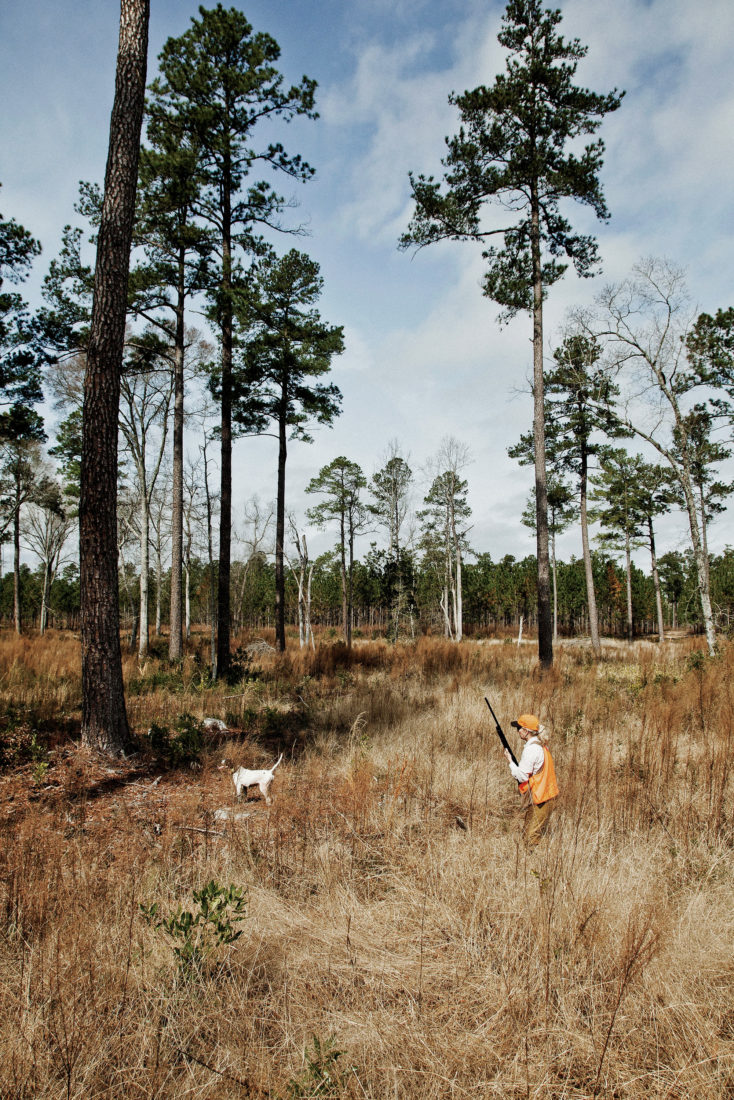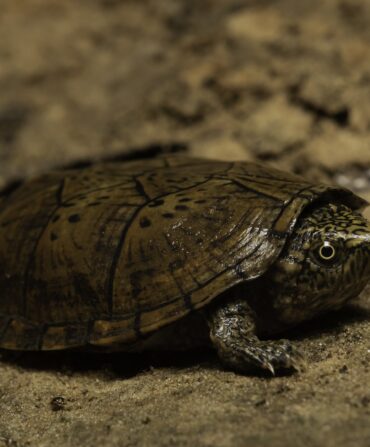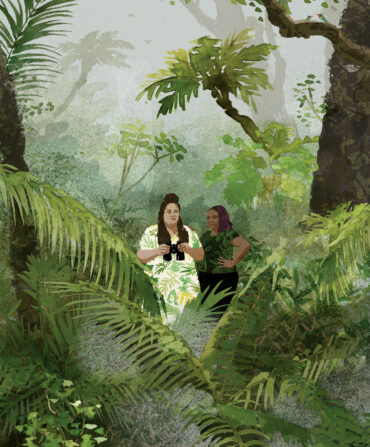David Douglas is an unbeliever, and an unapologetic heretic, at that. A builder, a bird hunter, a man in love with the South Carolina Lowcountry, he simply rejects the gospel widely held across the South that the age of wild bobwhite quail is past. That it is no longer feasible to have wild quail on private lands in numbers worth chasing with a bird dog and a scattergun. That farming changes, urbanization, increases in predator numbers, fire ants, pine plantations, and any of a litany of other modern quandaries have so diminished the prospects of Gentleman Bob that quail coveys and quail hunting and the sunrise whistles of a bobwhite brood are destined for relict status—available for occasional enjoyment, but nothing to fashion a farm, or a lifestyle, around.
Douglas will hear none of it. On historic lands his wife’s family amassed, along the cypress-shaded banks of the Little Pee Dee River, Douglas is restoring wild quail habitat and wild quail populations in ways that just might change the future for the South’s most iconic game bird. Thanks to an intensive program of habitat management and an innovative wild bird propagation technique developed by the private quail and Southern pinelands research facility Tall Timbers, Douglas is turning back time on several hundred acres of pines and fields and tangled swamps. He is a convert to a growing faith: that Southern quail and quail hunting just might rise again.
“You’ll have to shoot fast,” Douglas warns as I step through a winter-brown field of thigh-high weeds, reeds, and briars. Bearded and chatty, he wears denim brush pants and a pleasant bearing of near-constant optimism. Nellie, a German shorthaired pointer, has the birds pinned down, on point on the edge of the field’s low cover, right where the grasses grade to chest-high broomsedge and then to tall, columnar pines. Late-season birds are inherently skittish, invariably wary. The tinkle of a dog bell, the raking of nylon-faced brush pants through briars—anything can set them off, and when a covey of wild birds goes, it goes with a force and ferocity honed over the millennia.
The exact location of this quail covey is no accident, nor is its existence in general. We’re working through a “brood field,” a five-acre plot designed and maintained to provide cover for young quail. These brood fields are a critical component of Tall Timbers’ prescription for wild quail management, and a perfect example of a core philosophy of how landowners can make the switch between relying on pen-raised birds with their put-and-take hunting and a new paradigm of giving wild birds a chance.
Tall Timbers is a Tallahassee, Florida–based, privately funded 3,400-acre research facility founded in 1958 and based on the pioneering work of the father of modern science-based quail management, the much-lauded Herbert Stoddard. Over the last half century, Tall Timbers has been synonymous with the magnificent quail hunting found on the sprawling quail plantations of the Red Hills, a 300,000-acre swath of rolling open pinewood savannahs, carpets of golden wire grass, ancient lakes, and river swamp between Tallahassee and Thomasville, Georgia. There, about eighty historic quail plantations pour millions of dollars into managing for wild quail, with astounding results. Finding twenty to thirty coveys per day is not unusual for gunners who traditionally ride horses along meticulously mown grid paths, accompanied by mule-drawn dog carriages that hold as many as eight highly trained bird dogs.
What’s happening in South Carolina and elsewhere is a sister effort, carefully refined for smaller private land parcels outside Tall Timbers’ traditional Red Hills range. “We’ve tuned the Red Hills model to smaller scales, and we are exporting it to landowners with a few hundred acres instead of a few thousand, but with a similar passion for wild birds,” says Bill Palmer, Tall Timbers’ president and CEO. “We’re telling people that managing land for huntable populations of wild quail is doable, that the days of hunting wild quail in the South aren’t numbered at all.”
Under its South Carolina Quail Project, Tall Timbers is working with private landowners on more than 40,000 acres. Kicked off in March 2009 on Georgetown County’s Mount Pleasant Plantation, the project works to tailor habitat improvement prescriptions to specific land parcels. “We’re now working with twenty-two properties,” says Jerald Sholar, the Tall Timbers wildlife biologist who oversees the Palmetto State effort. “We’re changing the properties physically, but we’re also changing the landowners’ philosophy about how to approach land management and how to approach quail hunting. Our people are getting excited now about finding wild coveys of quail.” And find them they do. On Mount Pleasant, raising fifteen coveys of wild birds on a single hunt is exhilarating, but no longer a surprise South Carolina quail could hardly call a more storied stretch of Lowcountry woods home than the ground Douglas hunts. His wife, Christy Holliday Douglas, is the granddaughter of George J. Holliday, who converted much of the family’s 9,000 acres of pines and swamps to tobacco fields, and eventually became the nation’s largest tobacco grower. The family’s country store, begun in 1869, is still open, and is the site of the biannual Galivants Ferry Stump meeting, the oldest Democratic Party rally in the country. When Douglas approached the Holliday heirs with the prospect of turning part of their land into a laboratory for wild quail restoration, Christy and her sister, Russell, signed on without hesitation.
The sisters are the fourth generation of Hollidays on this land, and these are women who know the difference between a bluegill and a redbreast sunfish, who can sit in a deer stand all day long and yet move with ease between the sandy flatwoods of Galivants Ferry and Manhattan. Christy Douglas is an amateur historian who has collected family stories of the Galivants Ferry region into three books. Russell is a trustee of the South Carolina chapter of the Nature Conservancy and a past board member of the state’s Department of Natural Resources. Their father, John Monroe Holliday, was a passionate quail hunter who said with a straight face that he could find a hundred coveys of birds in a day. “Nobody had to teach us to like hunting—we grew up trailing behind Daddy and his bird dogs,” says Christy. When the Holliday lands were divided among the current generations of cousins, John Monroe Holliday told each heir how many coveys were on their inherited tracts.

Photo: Peter Frank Edwards
Christy Douglas and Russell Holliday in the field.
Tall Timbers’ prescription for the Hollidays’ 800-acre Lake Swamp tract is a prime example of the science-based approach the research station takes. It’s a one-two punch: First, incorporate habitat-management practices Tall Timbers has developed over the last half century, then seed the resultant quail ground with young birds from an innovative new program of artificially propagating wild-strain chicks.
Like many private land parcels in the South, the Lake Swamp property had evolved into a mosaic of traditionally managed pinelands, old fields in various stages of regrowth, and swamp borders so thick an ill wind couldn’t get through. Opening up the cover was both first aid and long-term health care. For long stretches, pines were thinned so that no two tree canopies could touch, allowing plenty of sunlight for the flush of grassland plants that support quail. Controlled burning of 50 percent of the cover each year will keep the woods clear, support spring and summer populations of nutrient-rich plants and bugs, and ensure that hunters can keep sight of their bird dogs and the quail they pursue.
In addition to open swaths of pines, brood fields, like the one in which Nellie pins down the quail, are vital. The basic Tall Timbers formula for highly productive quail habitat calls for managing a quarter to a third of the total acreage as brood fields, whose short stems of cover plants such as ragweed and partridge pea provide easy access to protein-rich insects during the critical first weeks of a bobwhite’s life. “On many quail properties, landowners spend more time and energy feeding birds than they do raising birds,” Sholar explains. “We work the habitat to maximize survival and reproduction because quail have a tremendous capacity to raise more birds if the habitat is there.”
In the grasslands that wend between the pines and the fields, a targeted mix of shrubs and low growth provides escape and nesting cover. “We’re not looking for those old quail-hunting magazine covers of nothing but pines and grass and coveys of birds flushing out in front of you,” Sholar says. Myrtle bushes, gallberries, and evergreen shrubs can be managed with herbicides and fire, and add a complexity to the habitat that birds need. Managing Southern pinelands like this is no mean feat. “This is not something to go into halfheartedly,” says Sholar. “There was a determination by this family to turn their property into the best quail land that was possible given the specific environment, and that requires a plan for every square inch of ground. We are proving that you don’t need thousands of acres to manage for quail. You need more than ten acres, certainly. But what you really need is commitment and a love of wild quail.”
And a plan for how to take advantage of ground a bobwhite might like to call home. The second step of the Tall Timbers prescription involves a revolutionary new way to raise wild quail for population enhancements on restored pinelands. Over the past three years, Tall Timbers researchers have worked to develop a method of producing wild-strain, parent-reared chicks—an undertaking that underscores how passionately Southern bird hunters feel about bobwhites.
It’s a fascinating process that attempts to replicate, as closely as possible, the special kind of adult-chick bonding and learning called imprinting. Before chicks even hatch from their eggs, they hear and recognize calls and sounds the hen makes, and this form of communication turns out to be critical for learning how to live as wild birds—including skills such as recognizing and avoiding predators. The novel Tall Timbers approach uses quail eggs collected from wild nests where the parent birds have been killed by predators or have otherwise abandoned the eggs. These eggs are incubated, and for thirty-six hours prior to hatching, recorded calls of parent hen quail are played to the nest, which helps synchronize hatching and begins the critical phase of imprinting. Once the young quail hatch, they are adopted by a parent bird and placed in an outdoor pen for about forty days.
“This gives us young birds with 100 percent wild genetics,” explains Bill Palmer. When the birds are ready for release, they are driven overnight to minimize human contact, then released early the next morning.
These birds aren’t cheap—each costs about fifteen dollars—but they allow a landowner “to go ahead and enjoy their investments in the land,” says Nat Ruth, manager of the Mount Pleasant Plantation, where the initial research on the wild-strain, parent-reared chicks took place. “Biologists will tell you that if you just provide the habitat, the birds will come. And they will, but it might be eight or ten years.”
On most Tall Timbers project areas, the new birds aren’t hunted for a period of two to three years to maximize their reproductive potential. At the Holliday place, the first parent-reared chicks were released in June 2011; over the next ten weeks, twenty broods of young quail were wing-tagged, trucked to Horry County, and turned out at the Lake Swamp tract. It’s early in the restoration process for Douglas’s birds, but he’s anxious to shoot just one or two of the wing-tagged birds to confirm that they’ve made it through six months under his care and that the family’s investments of time and resources are paying off. “This is as much about managing landowners’ expectations as it is pines or birds,” explains Sholar. “This early in the process, David Douglas might not shoot a lot of birds yet, but he is enjoying his land, enjoying what he’s done for that property, and enjoying the sight of wild quail tearing off in front of him. It’s hard to argue against that.”
That is the essence of the Tall Timbers program: bringing wild birds back to wild bird country. Pen-raised birds are fine and dandy, but even under the best of circumstances, they don’t flush like wild quail and don’t fly like wild quail and certainly don’t race the heart like wild bobwhites flushing from under a bird dog.
That’s clearly the case with the birds in front of Nellie. I take a single step in front of the pointer, and the covey bursts from cover. Most of the birds blow up and out and to the right, but a single veers left, catches my eye, and before I can even think about angles and lead and velocity, my over-and-under punches my shoulder twice and the single quail goes down.
I mark the spot as Nellie vaults in for the retrieve. When I glance over at Douglas, he is still looking toward the blue sky over the broomsedge, at the exact place where the covey disappeared into the South Carolina pines. His expression is nearly rapturous.
“Look at this. I can’t believe the transformation here.” Christy Douglas is striding briskly after the dogs, through scattered pines and broomsedge. Along one field edge squats a low log flue-cured-tobacco barn recently restored as a small deep-woods cabin. Two years ago, she says, “you wouldn’t have known that cabin was there. You couldn’t walk through here without falling down. No, I take that back. You could barely see your hand in front of your face in here, much less walk.”
By opening up thick woods for quail, the landowners have also opened up opportunities to experience and enjoy their land that they haven’t had in decades, if ever. “In a way, I’ve never really seen this property,” Christy says. “I’ve never been able to experience my own land in this way. And you can see how it looks like a place that would grow quail.”
“For years, our idea of managing for quail was to plant bicolor lespedeza,” David Douglas says. “We thought that was the be-all, end-all. With the new approach, it’s like having new ground in here. A few years back when I heard Jerald give a talk about the magic of what they were doing, that on some properties a population of two to three birds per acre was achievable, I thought that was completely laughable. We may or may not get there, but I can’t tell you how positively I feel about what we are doing. I really believe this may be the ticket.”
At the moment the dogs certainly do. Nellie and Slim, a liver-and-white pointer, nose into the wind. We trail dutifully behind. Their tails whip back and forth with excitement and expectation, each reddened with a smear of blood from the briars. They burrow through thickets of field borders, then vault across the open hunting lanes and into pinewoods where we can see them far ahead through the open trees.
David Douglas watches them intensely. It’s not like he’d given up on bird hunting entirely, he told me earlier. Before he brought Tall Timbers to Galivants Ferry, he could often go out and hunt hard and kill maybe four or five birds, and call that a banner day. “But that’s not what this land could be,” he said, eyes flashing. “That’s not what this land used to be. And that wasn’t good enough.”









